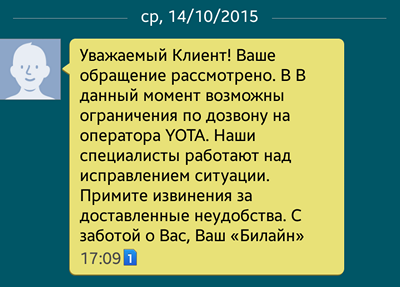Difficulties of "translation"

Perhaps one of you heard the other day that Beeline subscribers have not been able to reach Yota customers for some time, calls simply do not pass. Moreover, outgoing from Yota to Beeline are held in 100% of cases. Users report a disqualification from Beeline on social networks and complain massively about the support services of both operators.

')
In short, the situation can be described as follows: VimpelCom did not conduct timely scaling of its own network, underestimating the growth dynamics of our subscriber base. Today, over one million people use Yota mobile communications, not counting the customers of our modem product. As the ex-CEO of Yota Anatoly Smorgonsky said last year, our goal in the next five years is to gain about 10 million customers.


How the network is arranged, why this situation has arisen and what are the ways to solve it, read below.
Some theory
Being a full-fledged MVNO-operator, Yota gets the opportunity to use the existing radio network and switching equipment from its parent company MegaFon. In accordance with the law, each mobile operator, including Yota, must organize the necessary number of connections with other telecom operators in each federation subject and pass traffic according to a certain scheme. In our case:
- connection at the MG-level is sufficient with one operator (traffic is transmitted to / from the MG / MN-direction, as well as calls from / to numbers of other mobile operators, except MegaFon).
- interconnection at the zonal level with the operator providing zone fixed telephone services. Within this interface, voice calls (traffic transmission) are provided between our customers and fixed network subscribers (landline phones).
We organized these interconnections with our parent company in all subjects, and also organized a joint at the ATP-ATP level (calls between Yota customers and MegaFon subscribers).
The majority of operators MG / MN-junction is used to skip long-distance and international calls. When a call is made within the Yota network, for example, from Moscow to St. Petersburg, it gets into a trunk (trunk, trunk) of long-distance communication. In our case, the traffic to / from other mobile operators is also sent via MG / MN-junction.
Typically, mobile operators organize direct interconnections between their networks. That is, the ATP of operator A — ATP of operator B, the ATP of operator A — APS of operator B, etc. However, Yota does not have direct connections with other mobile operators, except for MegaFon, since we are an MVNO operator. We do not need this, because our main partner has organized all our connections to adjacent networks throughout the country. For this reason, all of our traffic in the direction of the ATP-operators (and from them) goes through the MG-connection.
Major mobile operators have their MGs. That is, in our existing scheme, when the VimpelCom subscriber calls the Yota client, the outgoing traffic first arrives at the VimpelCom MG node, and then either is sent to the MegaFon MG node and then through us, or goes through alternative transit operators . Each operator has the right to independently choose the scenarios for the delivery of calls of its subscribers to external networks, based on the order of traffic transmission, defined by regulatory legal acts, commercial priorities, quality and reliability of available routes, as well as many other criteria.

The above model of traffic transmission with certain features is valid for all operators. Each operator in each region has to implement their own communication scheme depending on the requirements of the regulatory legal acts (normative legal acts), network structure, number of subscribers and subscribers of other operators, ratio of incoming and outgoing calls.
The problem of underdog
As noted above, the Yota communication scheme does not use direct connections to the networks of other mobile operators. All Yota traffic, both incoming and outgoing to the numbers of other mobile operators, since the launch of the Yota mobile operator went into operation and goes through the MegaFon MG node. At the same time, we are fully responsible for providing outgoing calls to our subscribers. And the same applies to any other operator, regardless of the availability of direct connections. The lack of direct connections with other mobile operators does not affect the quality of service; we can, at our discretion, arrange for the transit of traffic through other operators in accordance with the requirements of the NLA.
When creating a communication scheme for any new operator, it is mandatory to conclude inter-operator agreements on traffic transmission between their networks. All operators in all constituent entities of the Russian Federation were promptly sent out alerts that the Yota numbering was launched on the basis of the MegaFon network, that you need to route certain ranges to certain trunks. Confirmations were received from all operators, including VimpelCom. This is a standard and mandatory procedure defined by the regulator for several years. In addition, traffic exams were tested with the main operators in each subject of the Russian Federation.
As follows from the above, it is incorrect to say that some subscribers of VimpelCom were not ringing out on our numbering with the existing communication scheme. If this were the case, Yota customers from the very beginning would have no connection either with Beeline or with other operators. The problem lies elsewhere.
It is important to understand that on the MG-direction, interconnections of operators are often unidirectional. That is, the traffic from the subscriber of the operator A to the subscriber of the operator B goes by one route, and the reverse traffic - by the other. And each operator is independently responsible for organizing the outgoing traffic of its subscribers to all other numbering. As applied to the current situation, VimpelCom provides the possibility of making calls from their subscribers to Yota numbering, and we provide calls from our customers to VimpelCom numbering.
The nuance is that each operator regularly has to expand its connections to MG nodes of other operators. This is done by increasing either the number of E1 streams (each provides up to 31 voice connections simultaneously) or SIP trunks. When the operator has a growing customer base, this leads to an increase in outgoing calls to the numbering of this operator. If the expansion is not carried out, then sooner or later the capacity of the existing flows will be insufficient. And then customers will begin to experience difficulties with dialing the numbers of the operator, accession to which has not been expanded. Of course, at night and early in the morning, when the load on the network is low, this problem may not be at all or it may not be massive. But in the rest of the time, when people begin to actively use the connection, due to the overload of the channels, there will be one call from 5-10-15, who is as lucky.

This was the reason why some VimpelCom subscribers could not reach Yota customers: the connection was not expanded in a timely manner. At the moment, the greatest difficulties with dialing from the VimpelCom network to Yota numbering are noted in Moscow, St. Petersburg and large million-plus cities.
Describing the difficulties encountered by the participants of the telecom-market in this post, we cannot fail to mention a similar problem, which at the end of September of this year took place in cooperation with another large MTS operator. People began to return from holidays, and as our subscriber base increased over the summer, the number of calls to Yota numbering began to rise sharply. As a result, there were massive difficulties with dialing from the MTS network to ours. After a joint discussion of the situation, MTS promptly implemented changes in voice traffic transfer scenarios in a number of regions, and complaints about the lack of calls from MTS to Yota stopped.
Regarding the current situation, negotiations are underway to expand the accessions on the side of VimpelCom. We hope that in the near future we can expect a successful resolution of the issue.
Source: https://habr.com/ru/post/268897/
All Articles